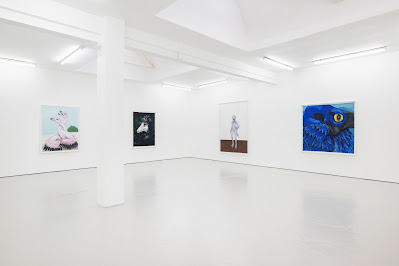Manuel Solano at Carlos/Ishikawa
What's in an expectation? At a time of ever-permeating anxieties, it sometimes feels better, nay safer, to have your expectations met. When something bad happens, and our expectations are low or we were anticipating the negative result, there is a bittersweet moment that envelops us, perhaps even a satisfying lull. All of this is to say that 'Ancestry', the latest exhibition by Berlin-based artist Manuel Solano, defies expectations, largely achieved through some unpacking and research into the artist. This presents itself as a potentially problematic catch-22, in that it raises the issue of whether an artist's biography should influence our perception of the artwork. A liberal stance, usually when an artist they have previously liked has come out as a bigot of some description, is often that we can separate the artist from their personality. This has always struck me as strange, but after all, delusion is bliss.
Although it may seem like an immediate derailing, the above is worth mentioning as the detail in question is that Solano is blind. I only know this from researching the artist further. I knew that there would be more to discover since visiting Carlos/Ishikawa, mostly as the paintings have an almost childlike quality to them, as if conveying a fresh wonder about primitive animal life. Given that the gallery is a big name in London's contemporary art scene, I was excited to delve deeper into the artist's practice. It feels necessary to state that the information is readily available, from interviews Solano has given in response to the interest around their work; I haven't exactly been rifling through their garbage.
Given the edge that contemporary art likes to bring to the table, I was keen to unpack the subject matter. One of my favourite paintings is 'Dinosauroid', a recent work reminiscent of a modern-day Shoebill. The figure stands upright on two legs, and has a warm, human-like quality, almost as if it is about to buy you a pint and have a gossip. According to Speculative Evolution Wiki (yes, really), the Dinosauroid is the figure representing the hypothesis formed in the 1970s and 1980s, suggesting that if non-avian dinosaurs had not been made extinct, they would have continued evolving and gained advanced intelligence similar to that of modern-day humans. So with some digging (if I may be permitted one archaeology-natural history semi-joke), the link between human emotion, personal experience and dinosaur paintings begins to take shape.
Another personal favourite in the show is 'Oviraptor 1', a large piece in the warmest, most transfixing hues of blue and cerulean. I felt an immediate draw to the work, partly because it feels more aesthetically pleasing than a regular scientific drawing of a dinosaur, although this is a trope throughout 'Ancestry'. This emotional response is amplified further after discovering that Solano lost their sight in 2014 as a result of a HIV-related illness. As I imagine most of the artist's audience would be, I am fascinated by their process of making, and their delivery of a subsequent queering of expectation. Upon hearing of Solano's blindness, I was firstly frustrated with myself that this changed my own perception of the work. A recent interview with Jo Lawson-Tancred at Artnet, which is even titled 'It's About Me as a Blind Person and Painter [...]', dragged me towards a realisation that, although my viewing experience is my own, there are limits to including myself in the narrative of a situation that, frankly, doesn't involve me. While an artist's work is out there for the audience, their identity and health status is not.
The introduction to the Artnet piece states that, since losing their eyesight, "each attempt [of making art] relies on memory", and while most practically this is a reference to technique, it also applies to evoking, and creatively reproducing, memories or themes of childhood, and their own past. Soon after reading various interviews and watching video content about Solano online, my fascination kept growing, and I was desperate to understand the personal meaning behind the subject matter we see in 'Ancestry'. Judging by the comparative wealth of material featuring Solano online, they are clearly of great interest to art press at large. A short film made by Institute of Contemporary Art Miami sees the artist talk about the fact that "I'm always talking about something in myself... I'm using [painting] to reflect an attitude or an experience in my life."
Through the film, ICA Miami offers insight into how Solano works, with a studio partner producing outlines for the works with string and nails, while the artist individually adopts a very physical method, using hands and fingers to mark-make and infiltrate the canvas. Yet, these recent works at Carlos/Ishikawa have a curious quality; they are intrinsically sweet, while thankfully falling undoubtedly short of being saccharine. This is especially the case with one painting, 'Leaellynasaurae', which shows a contemporary perspective of three small dinosaurs of the eponymous species, which had a tail three times the length of its body. There is also a quietly amusing aspect, hinting at the artist's personality, with works such as 'Siouxie' from 2021, conveying a dinosaur in the styling of the iconic frontwoman.
"Funny ways, our skins behaving
Pulsing through in ripples like a ruffling of feathers
Up the spine, atop both shoulders
And down my arms and into fluttering forearms
An involuntary voltage, however there for reasons of display[...]"
Manuel Solano





